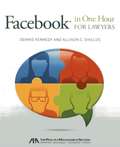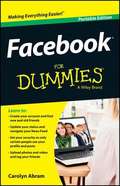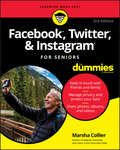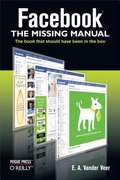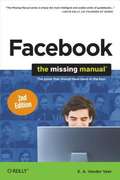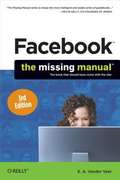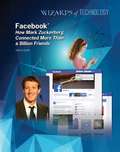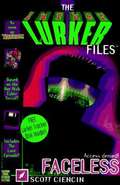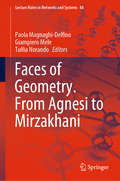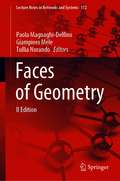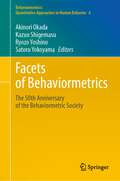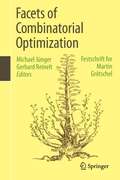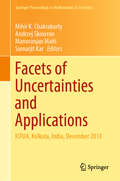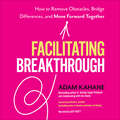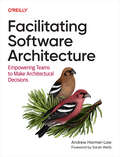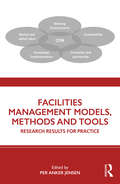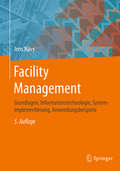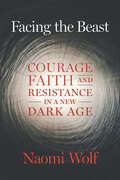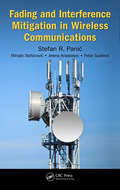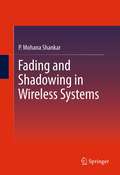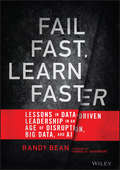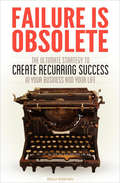- Table View
- List View
Facebook in One Hour for Lawyers
by Dennis Kennedy Allison C. ShieldsMany lawyers use Facebook(r), the world's most popular social networking platform, to communicate with friends and family across the globe. But lawyers are missing a major opportunity if they do not consider the business possibilities of their Facebook(r) accounts. With a few simple steps, lawyers can harness Facebook(r) to market their services, grow their practices, and expand their legal network--all by using the same methods they already use to communicate with friends and family. Facebook(r) in One Hour for Lawyers will show any attorney--from Facebook(r) novices to advanced users--how to use this powerful tool for both professional and personal purposes. In just one hour, you will learn to: Set up a Facebook(r) account Optimize privacy and other settings Create a profile and manage your timeline Find, organize, and manage friends Use Facebook(r) search and navigation Participate on Facebook(r) with updates, comments, likes, and timelines Send messages, join groups, and subscribe to feeds Establish a business page Monitor your Facebook(r) network Develop a Facebook(r) strategy to grow your legal network"
Facebook, Portable Edition
by Carolyn AbramLearn to: Create your account and find new and old friends Update your status and navigate your News Feed Set your security so only certain people see your profile and posts Upload photos and video and tag your friends Ready to get active on Facebook but have no clue where to start? This guide gets you going! So you've finally decided to join the "social network. " Maybe you have a Facebook account but want help navigating the site. This handy guide tells you how to get started, set up your Timeline, find friends, protect your privacy, and much more. Discover how Facebook helps you make new connections and keep up with old friends. Get the basics right - learn how to add personal info, send Friend Requests, and set privacy controls Reach out - find friends, start chat sessions, share photos, and use tags Choose your audience - fine-tune the Friend Lists that Facebook makes for you Show off your smiling face - share your photos and videos with your Facebook friends Manage your profile - choose what you want to share and find out how to make changes to your information Keep in touch - contact your friends using private or public messages Open the book and find: Steps for finding and connecting with friends on Facebook Tips for changing your profile picture and cover photo How to tell your story in Timeline Privacy controls and how to set them Advice for parents of teens on Facebook Ways to interact with friends using comments, likes, and sharing
Facebook, Surfen und Co.: So ist mein Kind sicher im Internet
by Jane SchmidtKinder und Jugendliche bewegen sich heutzutage wie selbstverständlich im Internet - sei es mit dem Computer oder dem Smartphone. Dies ist auch durchaus unterstützenswert, da sie von zahlreichen Informations-, Kommunikations- und Unterhaltungsangeboten profitieren können. Die Vielzahl der Möglichkeiten bringt allerdings auch einige Gefahren mit sich - dieses Buch zeigt Ihnen, wie Sie Ihr Kind sicher davor schützen. Sie erfahren, wie Sie den Computer oder das Smartphone kindersicher einrichten, wie Ihr Kind spielerisch lernen kann, welche privaten Informationen es unbedingt schützen sollte, und wie es echte Freunde von zwielichtigen Fremden unterscheidet. Außerdem wird thematisiert, was Sie tun können, wenn Ihr Kind Opfer von Cybermobbing wird, versehentlich ein Abo abgeschlossen hat oder wenn aufgrund eines illegalen Musik- oder Film-Downloads eine Abmahnung ins Haus flattert. Und da sich gerade Jugendliche des Öfteren zurückziehen, erfahren Sie auch, woran Sie erkennen, ob Ihr Kind möglichweise schon onlinesüchtig ist. Im zweiten Teil des Buchs dreht sich dann alles konkret um die bei Kindern und Jugendlichen beliebtesten sozialen Netzwerke Facebook, Google+, YouTube, Twitter, Pinterest, Instagram und Foursquare. Sie lernen, worauf Ihr Kind grundsätzlich achten sollte, und legen Schritt für Schritt Profile an, die so abgesichert sind, dass die nächste "Facebook-Party" bestimmt nicht bei Ihnen stattfinden wird!
Facebook, Twitter, and Instagram For Seniors For Dummies
by Marsha CollierEnjoy the top social media sites with ease and security Done correctly, social media is a way to connect friends, family, and the world while still maintaining security and privacy. Facebook, Twitter, & Instagram For Seniors For Dummies, 3rd Edition offers advice on how to enjoy the three most popular social media options while avoiding worry about who sees what you share. Written by social media expert Marsha Collier, this book walks you through establishing accounts, making connections, and sharing content including photos and video. You learn the settings to adjust on each platform to maintain privacy and filter out the content you don't want. This book also explains the subtle art of avoiding or blocking people on social platforms without jeopardizing your real-world relationships! Take control of what you share Connect with others Take and share your best pictures Use social media as a news source Social media sites are great fun once you learn how to cut through the clutter—and this book shows you how!
Facebook: The Missing Manual
by E. A. Vander VeerFacebook is the wildly popular, free social networking site that combines the best of blogs, online forums and groups, photosharing, clever applications, and interaction among friends. The one thing it doesn't have is a users guide to help you truly take advantage of it. Until now. Facebook: The Missing Manual gives you a very objective and entertaining look at everything this fascinating Facebook phenomenon has to offer. Teeming with high-quality color graphics, each page in this guide is uniquely designed to help you with specific Facebook tasks, such as signing up, networking, shopping, joining groups, finding or filling a job, and a whole lot more. You'll discover how to create your page and make connections with other members in no time -- everybody who went to your school, for example, or those who work at your company or play on your soccer team. Bingo: instant access to the personal and professional details of all the folks you're connected with, the folks they're connected with, and so on, and so on. With Facebook: The Missing Manual, you learn to: Join a network, whether it's in your area, or work-related, or based on other interests Look up old friends, find new ones, and decide who you'd like to keep track of Contact members by poking them, writing on their walls, and sending them gifts Get automatic updates from Facebook friends and send updates to them Participate in groups of particular interest and hook up with members face-to-face Buy and sell using Facebook's uniquely targeted marketplace and classified ads Find a job or hire employees by combing through Facebook's member pool Use Facebook as a collaboration tool to keep team members, co-workers, clients, and projects up to date Play it safe by using a multi-pronged approach to ensuring your privacy Think of Facebook as a 30-million-plus-entry searchable Rolodex on steroids! With help from this Missing Manual, you'll quickly get in the swim of the Facebook experience -- without getting in over your head.
Facebook: The Missing Manual
by E. A. Vander VeerFacebook's popularity is skyrocketing, drawing more than 400 million people to this combination online village green, personal website creator, and souped-up address book. But one thing you won't get when signing up is a printed manual. Enter Facebook: The Missing Manual, Second Edition -- the witty, authoritative guide you need, now revised and updated to include all of Facebook's latest features. Coverage includes: Getting started, getting connected. Signing up is easy, but the real payoff comes when you tap into networks of coworkers, classmates, and friends. This book explains it all-including how to pick and choose who gets to see what, and how to steer clear of people you want to avoid. Adding applications. Ranging from silly (fortune cookies and video games) to serious (goal tracking), thousands of mini-programs can transform your Facebook account into an addictive, one-stop resource. Learn how to find and install your favorites. Facebook for grownups and businesspeople. Facebook isn't just for Junior anymore. Thousands of companies and business professionals use the site for everything from project collaboration and advertising to filling (and finding) jobs. This book is written for adults of all ages. Protecting your privacy. Creeps are everywhere online, but on Facebook you can feel especially exposed with so much personal info on display. This book offers an easy-to-follow, multi-pronged approach to staying safe.
Facebook: The Missing Manual
by E. A. Vander VeerFacebook's spreading about as far and fast as the Web itself: 500 million members and counting. But there's a world of fun packed into the site that most folks miss. With this bestselling guide, learn how to unlock Facebook's talents as personal website creator, souped-up address book, and bustling community forum. It's an eye-opening, timesaving tour, guaranteed to help you get the most out of your Facebook experience. Coverage includes: Get started, get connected. Signing up is easy, but the real payoff comes when you tap into networks of coworkers, classmates, and friends. Pick and choose who gets to see what, and learn how to steer clear of people you want to avoid. Add applications. Transform your Facebook account into an addictive, one-stop resource with thousands of mini-programs, ranging from silly to serious. Go professional. Facebook isn't just for college kids. Thousands of companies and businesspeople use the site for everything from project collaboration and advertising to filling (and finding) jobs. You'll learn all the tricks. Protect your privacy. You may feel too exposed with so much personal info on display. This book features an easy-to-follow, multi-pronged approach to staying safe on Facebook.
Facebook®: How Mark Zuckerberg Connected More Than a Billion Friends
by Celicia ScottToday, Facebook is one of the most-used websites on the Internet, visited by millions of users each day and home to more than 500 million accounts. Many people use Facebook to share pictures, news, and ideas with friends--but they may not know the true story behind Facebook's massive success. Facebook began as the idea of one college student: Mark Zuckerberg. Discover how Mark founded one of the most successful social networking sites on the Internet while he was still in school. Learn how he first got Facebook growing, and how he keeps millions of people logging in day after day. Find out more about the man behind Facebook--and learn what's next for his company.
Facebook—Can Ethics Scale in the Digital Age?
by Carin-Isabel Knoop George A. RiedelSince its founding in 2004, Facebook has built a phenomenally successful business at global scale to become the fifth most valuable public company in the world. The revelation of Cambridge Analytica events in March 2018, where 78 million users' information was leaked in a 2016 US election cycle, exposed a breach of trust/privacy amongst its user community. In the past, growth at any costs appeared to be the de facto strategy. Now many voices such as regulators, advertisers, ethicists, shareholders and users argued for a more responsible approach to addressing their concerns. Mark Zuckerberg (CEO/Chair/Founder) and Sheryl Sandberg (COO) mapped out their six-point plan to address this existential threat. Could they continue to grow and rectify the breach of trust/privacy? Did other stakeholders have some greater responsibility too? In addition to issues of privacy and trust, there is a growing chorus of concern about "content moderation" - not for the easy topics like spam or copyright material -but for the hard things around political points of view, hate speech, polarizing perspectives, etc. How will Facebook strike the balance between free speech and corrosive content across billions of users and dozens of languages? Are they the arbiters of truth/censorship in the digital world?
Faceless (The Lurker Files #1)
by Scott CiencinPlaying the popular campus video game, The Lurker, Josh Stewart is horrified to learn that his roommate and opponent, Wreak Havoc, is out to secure Josh's permanent elimination.
Faces of Geometry. From Agnesi to Mirzakhani (Lecture Notes in Networks and Systems #88)
by Paola Magnaghi-Delfino Giampiero Mele Tullia NorandoThe volume reports on interdisciplinary discussions and interactions between theoretical research and practical studies on geometric structures and their applications in architecture, the arts, design, education, engineering, and mathematics. These related fields of research can enrich each other and renew their mutual interest in these topics through networks of shared inspiration, and can ultimately enhance the quality of geometry and graphics education. Particular attention is dedicated to the contributions that women have made to the scientific community and especially mathematics. The book introduces engineers, architects and designers interested in computer applications, graphics and geometry to the latest advances in the field, with a particular focus on science, the arts and mathematics education.
Faces of Geometry: II Edition (Lecture Notes in Networks and Systems #172)
by Paola Magnaghi-Delfino Giampiero Mele Tullia NorandoThe volume reports on interdisciplinary discussions and interactions between theoretical research and practical studies on geometric structures and their applications in architecture, the arts, design, education, engineering, and mathematics. These related fields of research can enrich each other and renew their mutual interest in these topics through networks of shared inspiration, and can ultimately enhance the quality of geometry and graphics education. Particular attention is dedicated to the contributions that women have made to the scientific community and especially mathematics. The book introduces engineers, architects and designers interested in computer applications, graphics and geometry to the latest advances in the field, with a particular focus on science, the arts and mathematics education.
Facets of Behaviormetrics: The 50th Anniversary of the Behaviormetric Society (Behaviormetrics: Quantitative Approaches to Human Behavior #4)
by Akinori Okada Kazuo Shigemasu Satoru Yokoyama Ryozo YoshinoThis edited book is the first one written in English that deals comprehensively with behavior metrics. The term “behaviormetrics” comprehends the research including all sorts of quantitative approaches to disclose human behavior. Researchers in behavior metrics have developed, extended, and improved methods such as multivariate statistical analysis, survey methods, cluster analysis, machine learning, multidimensional scaling, corresponding analysis or quantification theory, network analysis, clustering, factor analysis, test theory, and related factors. In the spirit of behavior metrics, researchers applied these methods to data obtained by surveys, experiments, or websites from a diverse range of fields. The purpose of this book is twofold. One is to represent studies that display how the basic elements of behavior metrics have developed into present-day behavior metrics. The other is to represent studies performed mainly by those who would like to pioneer new fields of behavior metrics and studies that display elements of future behavior metrics. These studies consist of various characteristics such as those dealing with theoretical or conceptual subjects, the algorithm, the model, the method, and the application to a wide variety of fields. This book helps readers to understand the present and future of behavior metrics.
Facets of Combinatorial Optimization: Festschrift for Martin Grötschel
by Michael Jünger Gerhard ReineltMartin Grötschel is one of the most influential mathematicians of our time. He has received numerous honors and holds a number of key positions in the international mathematical community. He celebrated his 65th birthday on September 10, 2013. Martin Grötschel's doctoral descendant tree 1983-2012, i.e., the first 30 years, features 39 children, 74 grandchildren, 24 great-grandchildren, and 2 great-great-grandchildren, a total of 139 doctoral descendants. This book starts with a personal tribute to Martin Grötschel by the editors (Part I), a contribution by his very special "predecessor" Manfred Padberg on "Facets and Rank of Integer Polyhedra" (Part II), and the doctoral descendant tree 1983-2012 (Part III). The core of this book (Part IV) contains 16 contributions, each of which is coauthored by at least one doctoral descendant. The sequence of the articles starts with contributions to the theory of mathematical optimization, including polyhedral combinatorics, extended formulations, mixed-integer convex optimization, superclasses of perfect graphs, efficient algorithms for subtree-telecenters, junctions in acyclic graphs, and preemptive restricted strip covering, as well as efficient approximation of non-preemptive restricted strip covering. Combinations of new theoretical insights with algorithms and experiments deal with network design problems, combinatorial optimization problems with submodular objective functions, and more general mixed-integer nonlinear optimization problems. Applications include VLSI layout design, systems biology, wireless network design, mean-risk optimization, and gas network optimization. Computational studies include a semidefinite branch and cut approach for the max k-cut problem, mixed-integer nonlinear optimal control, and mixed-integer linear optimization for scheduling and routing of fly-in safari planes. The two closing articles are devoted to computational advances in general mixed integer linear optimization, the first by scientists working in industry, the second by scientists working in academia. These articles reflect the "scientific facets" of Martin Grötschel who has set standards in theory, computation, and applications.
Facets of Uncertainties and Applications
by Andrzej Skowron Mihir K. Chakraborty Manoranjan Maiti Samarjit KarSince the emergence of the formal concept of probability theory in the seventeenth century, uncertainty has been perceived solely in terms of probability theory. However, this apparently unique link between uncertainty and probability theory has come under investigation a few decades back. Uncertainties are nowadays accepted to be of various kinds. Uncertainty in general could refer to different sense like not certainly known, questionable, problematic, vague, not definite or determined, ambiguous, liable to change, not reliable. In Indian languages, particularly in Sanskrit-based languages, there are other higher levels of uncertainties. It has been shown that several mathematical concepts such as the theory of fuzzy sets, theory of rough sets, evidence theory, possibility theory, theory of complex systems and complex network, theory of fuzzy measures and uncertainty theory can also successfully model uncertainty.
Facilitating Breakthrough: How to Remove Obstacles, Bridge Differences, and Move Forward Together
by Adam KahaneA new approach to helping teams solve complex and stubborn problems from the acclaimed author of Collaborating with the Enemy. It&’s becoming less straightforward for people to move forward together. They face increasing complexity and decreasing control. They need to work with more people from across more divides. In such situations, the most common ways of advancing—some people telling others what to do, or everyone just doing what they think they need to—aren&’t adequate. One better way is through facilitating. But the most common approaches to facilitating—bossy vertical directing from above or collegial horizontal accompanying from alongside—also aren&’t adequate. They often leave the participants frustrated and yearning for breakthrough. This book describes a new approach: transformative facilitation. Instead of choosing the bossy vertical or collegial horizontal approach: It cycles back and forth between them. Rather than forcing or cajoling, the facilitator removes the obstacles that stand in the way of people contributing and connecting equitably, enabling them to bring their whole selves to the process. This book is for anyone who helps people work together to transform their situation, be it a professional facilitator, manager, consultant, coach, chairperson, organizer, mediator, stakeholder, or friend. It offers a broad and bold vision of the contribution that facilitation can make to helping people collaborate to make progress. Praise for Adam Kahane&’s books &“Thought-provoking discourse on handling difficult situations.&” —Publishers Weekly &“Profound . . . a wise way to negotiate our toughest group, community, and societal challenges.&” —William Ury, New York Times–bestselling coauthor of Getting to Yes
Facilitating Software Architecture: Empowering Teams to Make Architectural Decisions
by Andrew Harmel-LawThe software architect role is evolving. As systems and their interactions with the teams that build, run, and evolve them become more complex, it's often impossible for those playing the traditional architect roles to be everywhere they need to be. There's simply too much architecture to be done, and the situation has reached a breaking point. There's a better way. Author Andrew Harmel-Law shows you how architects and development teams can collaborate to create and evolve more efficient architectures for their systems. Techniques in this book will help you learn how to create a mindset that allows everyone to practice architecture and build the best systems they've ever experienced. With this book, you will:Understand the new dynamics that affect modern software deliveryLearn a methodology that brings software architecture and development togetherNurture the fundamental interplay of decisions, advice, architecture, and feedback from running systemsInitiate practices that maximize benefits and mitigate risksCreate an approach tuned to architecture, everyone's skills, and your organization's culture
Facilities Management Models, Methods and Tools: Research Results for Practice
by Per JensenThis book presents research tested models, methods and tools that can make the work of the facilities manager more robust and sustainable, help long-term strategic planning and support students and practitioners in FM to improve the way they approach and deal with challenges in practice. The 34 models, methods and tools are presented in relation to five typical challenges for facilities managers: Strategy development Organisational design Space planning Building projects Optimisation The chapters are short and concise, presenting a central illustration of one model, method or tool with explanatory text and short, exemplary case studies. Each chapter includes references to further reading, and the book includes a keyword index. Essential reading for all involved in the management of built assets, this book bridges the gap between robust academic research and practical industry tools. It can also be used as a handy student reference.
Facility Management: Grundlagen, Informationstechnologie, Systemimplementierung, Anwendungsbeispiele
by Jens NävyIndustrie- und Wohnungsunternehmen verwalten ihre Gebäude, Anlagen und Grundstücke mit Hilfe des Facility Management (FM). Dieses Buch informiert über die Informationstechnologie im FM. Das Computer Aided Facility Management (CAFM) bildet dabei den Schwerpunkt. Gegenüber der 3. Auflage sind die Marktübersicht und Ausführungen dazu aktualisiert. Der Autor betreibt selber beratend die Professionalisierung der Gebäude- und Immobilienbewirtschaftung.
Facing the Beast: Courage, Faith, and Resistance in a New Dark Age
by Naomi WolfFrom New York Times bestselling author Naomi Wolf, Facing the Beast is a devastating, detailed account of wrongthink, deplatforming, and an unexpected political, personal, and spiritual transformation that followed during one of the most divisive times in American history.In this uncompromising investigation into today&’s most urgent issues, Naomi Wolf uses her own wildly politicized pilgrimage—from New York Times bestselling author and high-level Democratic consultant to a journalist cast out from the elite political and social circles she once moved through—as a stunning narrative framework that is both chilling and incisive.Wolf&’s sin? Doing the job that good journalists once prided themselves on: asking questions, challenging authority, and, during one of the most politically divisive moments in modern history, exposing the many failures of the public health response during the COVID-19 pandemic by chronicling the dangerous descent of our democracy into tyranny, censorship, and totalitarianism.Unable to remain silent in the shadows and unwilling to collude with the mainstream, Wolf bravely covers topics that few other writers dare to address critically for fear of being deplatformed. Facing the Beast explores reproductive rights, medical freedom, the uncurious thought-policing of the &“progressive&” left, the Second Amendment, the criminal relationship between the FDA and Pfizer—Wolf&’s clear writing repeatedly shines light in the dark corners of our fractured society.A decades-long champion of free speech, freedom of the press, and the Constitution, Wolf found herself not only in the midst of a political rebirth but a spiritual transformation as well—one in which the events of the day could only be described in terms of good, evil, and a metaphysical quest on the nature of reality.For readers of Matt Taibbi, Glenn Greenwald, and Bari Weiss, Facing the Beast is a fearless indictment of legacy media and the political class, as well as a brutal reminder that searching for and defending the truth can be dangerous.&“Naomi Wolf is one of the bravest, clearest-thinking people I know. The reason you hear the forces of repression so desperately trying to dismiss her is because she is right.&”—Tucker Carlson
Fading and Interference Mitigation in Wireless Communications
by Stefan Panic Mihajlo Stefanovic Jelena Anastasov Petar SpalevicFading and Interference Mitigation in Wireless Communications will help readers stay up to date with recent developments in the performance analysis of space diversity reception over fading channels in the presence of cochannel interference. It presents a unified method for computing the performance of digital communication systems characterized by a variety of modulation and detection types and channel models. The book includes coverage of multichannel reception in various fading environments, influence of cochannel interference, and macrodiversity reception when channels are simultaneously affected by various types of fading and shadowing.
Fading and Shadowing in Wireless Systems
by P. Mohana ShankarThe study of signal transmission and deterioration in signal characteristics as the signal propagates through wireless channels is of great significance. The book presents a comprehensive view of channel degradation arising from fading and shadowing. Various statistical models including simple, hybrid, compound, complex and cascaded ones are presented with detailed derivations along with measures to quantify the deterioration such as the amount of fading, error rates and outage probabilities. The models range from the Rayleigh and Rician through Suzuki, generalized K, cascaded and alpha-mu and similar ones. This is followed by the analysis of mitigation of fading and shadowing through diversity (simple, hybrid, micro- and macro- level) and combining algorithms. The density and distribution functions, error rates and outages are derived and results analyzed to quantify the improvements. The effects of co-channel interference before and after the implementation of diversity are also analyzed. To facilitate easy understanding of the models and analysis, the background information in terms of probability and random variables is presented with relevant derivations of densities of linear and nonlinear transformation of random variables, the sums, products, ratios as well as order statistics of random variables of all types. The book also provides material on digital modems of interest in wireless systems. Thus, the book with 1100+ equations and 350+ Matlab generated figures and tables is an ideal source for students, educators, researchers and professionals in wireless communications allowing access to information currently unavailable.
Fail Fast, Learn Faster: Lessons in Data-Driven Leadership in an Age of Disruption, Big Data, and AI
by Randy BeanExplore why — now more than ever — the world is in a race to become data-driven, and how you can learn from examples of data-driven leadership in an Age of Disruption, Big Data, and AI In Fail Fast, Learn Faster: Lessons in Data-Driven Leadership in an Age of Disruption, Big Data, and AI, Fortune 1000 strategic advisor, noted author, and distinguished thought leader Randy Bean tells the story of the rise of Big Data and its business impact – its disruptive power, the cultural challenges to becoming data-driven, the importance of data ethics, and the future of data-driven AI. The book looks at the impact of Big Data during a period of explosive information growth, technology advancement, emergence of the Internet and social media, and challenges to accepted notions of data, science, and facts, and asks what it means to become "data-driven." Fail Fast, Learn Faster includes discussions of: The emergence of Big Data and why organizations must become data-driven to survive Why becoming data-driven forces companies to "think different" about their business The state of data in the corporate world today, and the principal challenges Why companies must develop a true "data culture" if they expect to change Examples of companies that are demonstrating data-driven leadership and what we can learn from them Why companies must learn to "fail fast and learn faster" to compete in the years ahead How the Chief Data Officer has been established as a new corporate profession Written for CEOs and Corporate Board Directors, data professional and practitioners at all organizational levels, university executive programs and students entering the data profession, and general readers seeking to understand the Information Age and why data, science, and facts matter in the world in which we live, Fail Fast, Learn Faster p;is essential reading that delivers an urgent message for the business leaders of today and of the future.
Failure Is Obsolete: The Ultimate Strategy to Create Recurring Success in Your Business and Your Life
by Benji RabhanA data-driven way to make smarter decisions every day: &“One of the smartest conversion guys I know&” (Perry Marshall, author of The Ultimate Guide to Google AdWords). Failure Is Obsolete reveals an easy-to-use formula for testing high-risk ideas in a low-risk environment, providing increased likelihood of success before you waste a lot of time and money moving in the wrong direction. Be more confident in your business decisions—from creating new products to hiring employees and launching new marketing campaigns—as well as personal decisions like dating or choosing a retirement home. This useful strategy evolves from the author&’s years of experience in conversion rate optimization, helping companies improve their websites and marketing funnels so they make more money. In addition, Failure Is Obsolete reveals some of Benji Rabhan&’s best conversion techniques that readers can use on their own websites.
Failure to Connect: How Computers Affect Our Children's Minds and What We Can Do About It
by Jane M. HealyIn this comprehensive, practical, and unsettling look at computers in children's lives, Jane M. Healy, Ph.D., questions whether computers are really helping or harming children's development. Once a bedazzled enthusiast of educational computing but now a troubled skeptic, Dr. Healy examines the advantages and drawbacks of computer use for kids at home and school, exploring its effects on children's health, creativity, brain development, and social and emotional growth. Today, the Federal Government allocates scarce educational funding to wire every classroom to the Internet, software companies churn out "educational" computer programs even for preschoolers, and school administrators cut funding and space for books, the arts, and physical education to make room for new computer hardware. It is past the time to address these issues. Many parents and even some educators have been sold on the idea that computer literacy is as important as reading and math. Those who haven't hopped on the techno bandwagon are left wondering whether they are shortchanging their children's education or their students' futures. Few people stop to consider that computers, used incorrectly, may do far more harm than good. New technologies can be valuable educational tools when used in age-appropriate ways by properly trained teachers. But too often schools budget insufficiently for teacher training and technical support. Likewise, studies suggest that few parents know how to properly assist children's computer learning; much computer time at home may be wasted time, drawing children away from other developmentally important activities such as reading, hobbies, or creative play. Moreover, Dr. Healy finds that much so-called learning software is more "edutainment" than educational, teaching students more about impulsively pointing and clicking for some trivial goal than about how to think, to communicate, to imagine, or to solve problems. Some software, used without careful supervision, may also have the potential to interrupt a child's internal motivation to learn. Failure to Connect is the first book to link children's technology use to important new findings about stages of child development and brain maturation, which are clearly explained throughout. It illustrates, through dozens of concrete examples and guidelines, how computers can be used successfully with children of different age groups as supplements to classroom curricula, as research tools, or in family projects. Dr. Healy issues strong warnings, however, against too early computer use, recommending little or no exposure before age seven, when the brain is primed to take on more abstract challenges. She also lists resources for reliable reviews of child-oriented software, suggests questions parents should ask when their children are using computers in school, and discusses when and how to manage computer use at home. Finally, she offers a thoughtful look at the question of which skills today's children will really need for success in a technological future -- and how they may best acquire them. Based on years of research into learning and hundreds of hours of interviews and observations with school administrators, teachers, parents, and students, Failure to Connect is a timely and eye-opening examination of the central questions we must confront as technology increasingly influences the way we educate our children.
